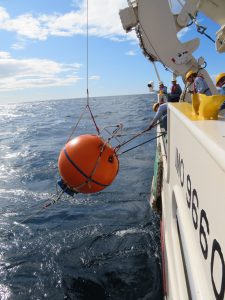General ocean circulation plays a large role in the global climate, environment, and ecosystem by transporting heat, greenhouse gases, nutrients, and plankton.

The Kuroshio and Oyashio currents form the upper-ocean circulation and build a complicated ocean structure in the region east of Japan and influence climate and ecosystem variability on interannual to multi-decadal timescales. Climate variability with longer time scales of particularly more than decades to a hundred years is affected by the intermediate and deep circulations. The deep circulation starts from the North Atlantic, flows through the Antarctic Ocean, and finally reaches the North Pacific where the upwelling to the shallower deep layer occurs. Part of the upwelling is caused by turbulent vertical mixing. The deep circulation is also a key element in global warming.
We investigate the properties and dynamics of general ocean circulation including the formation, distribution, and variation of water masses. We primarily focus on the ocean circulation of the North Pacific.
Ongoing Research Themes
Variability of upper ocean circulation in the Pacific
Variations of currents and the associated temperature/salinity structure in upper oceans have a great impact on variations of climate and fisheries resources. We study these variations by analyzing the data from a recently developed global observing system and our observations.
Observation and dynamics of Pacific intermediate and deep circulations and mixing
The North Pacific is critically important for understanding deep and intermediate ocean circulations, and presents many challenges. The mechanisms of the circulations, upwelling and vertical mixing are the biggest questions in oceanography. We investigate the state and dynamics of deepand intermediate water circulations, upwelling and mixing using water analyses, moorings, underwater gliders with turbulence sensors, shipboard observations and model calculations.
Long-term variations of climate, ocean and ecosystem
On the basis of unique hypothesis that 18.6-year period tidal cycle regulates the long-term variability through tide-induced vertical mixing, we observe and model the Okhotsk Sea, the Oyashio and the Kuroshio, and study multi-decadal variability.